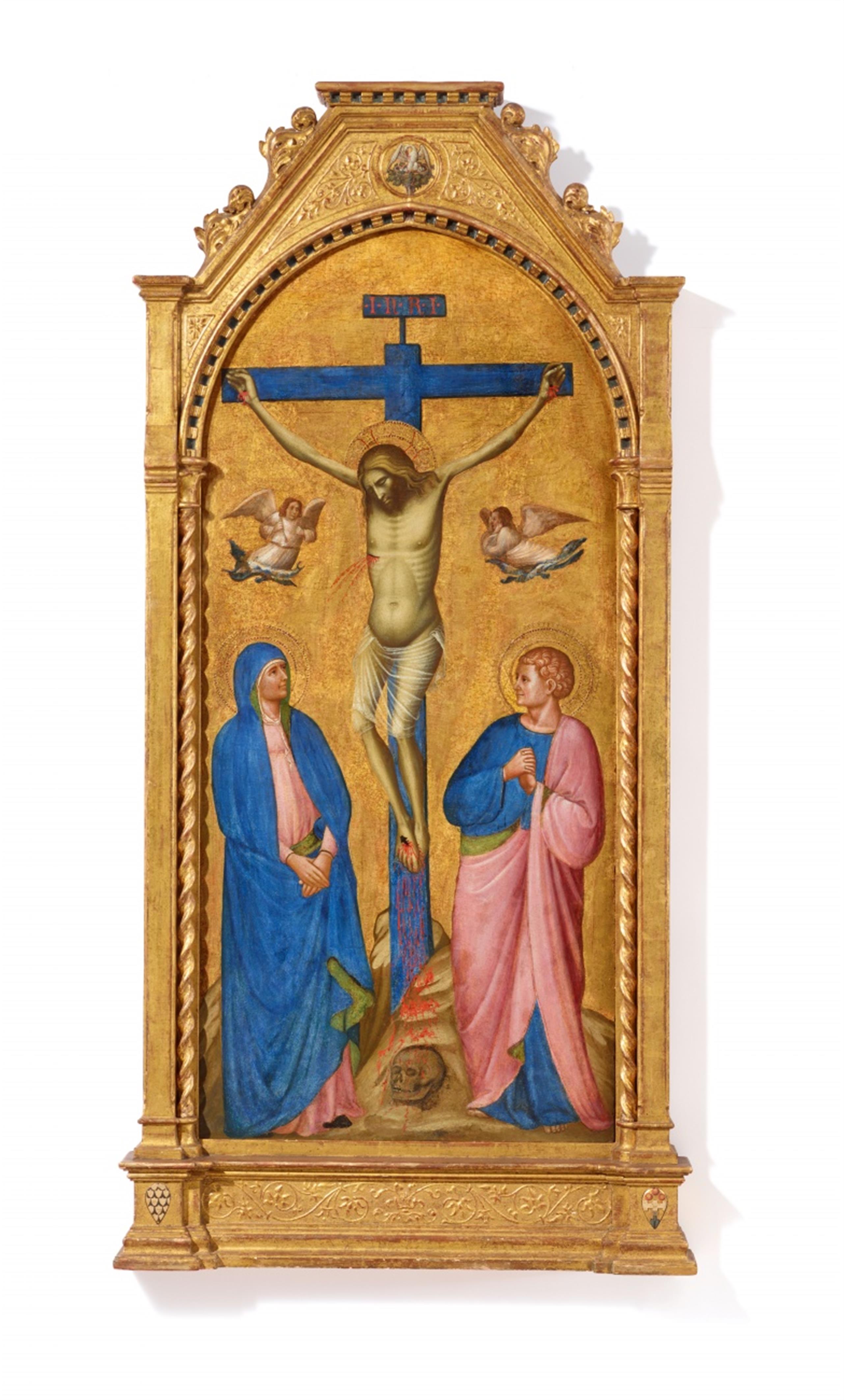Giovanni da Bologna
The Crucifixion with the Virgin Mary and St. John the Evangelist
Tempera and gold leaf on panel. 165.4 x 77.2 cm.
This Crucifixion scene is the only work by Giovanni da Bologna in private ownership. Giovanni da Bologna was active in Venice and northern Italy - in Padua, Bologna and Treviso - in the latter half of the 14th century. His work is of great art historical significance not only for its exceptional quality, but also for the mediating role he played between these artistic centres. His style had its origin in the painting of Lorenzo Veneziano, the leading artist of Venice in the second half of the 14th century. However, in Padua and Bologna he came into contact with a new manner of painting, and he brought these tendencies back to Venice. The artistic style developed on the mainland drew on the works of Giotto from the beginning of the century and was characterized by a new sense of realism as well as a new intensity in the depiction of emotions. According to Guarnieri, "Giovanni da Bologna (...) is considered the leading representative of the fusion between Bolognese and Venetian artistic characteristics and, accordingly, as an important mediator of modern art, which, beginning on the Terraferma, slowly permeated and revitalised the tired and repetitive Gothic-Byzantinising Venetian school (“... considerato ora il più felice rappresentante della fusione dei caratteri bolognesi con quelli veneziani e perciò tramite importante dell'arte moderna che dalla terraferma lentamente penetrava e rivitallizzava la stanca e ripetitiva scuola gotico-bizzantineggiante veneziana...”; Guarnieri, op.cit., p. 32). This Crucifixion scene, previously housed in several important private collections, is an outstanding example of the new artistic style propagated by Giovanni da Bologna in the second half of the Trecento.
Giovanni da Bologna's oeuvre can be reconstructed on the basis of a series of documents and signed works. He is mentioned in documents from 1377 and 1378 in Treviso, which then formed part of the Venetian terraferma, as “magister Iohannes de Salamone impictor quondam ser Albertini de Regio”. In 1385 he is registered in Venice in the parish of San Luca, and he drew up his will in 1389. Besides Venice and Treviso, he was also active in Padua and Bologna.
Four signed works by Giovanni da Bologna have survived and are now housed in important museums: A Madonna dell'umiltà in the Pincoteca di Brera, Milan (fig. 1); another Madonna dell'umiltà in the Gallerie dell'Accademia, Venice; a Coronation of the Virgin in the Denver Art Museum, Denver/Colorado (fig. 2); and a St. Christopher in the Civici Musei agli Eremitani, Padua. Other works are housed in the Pinacoteca Nazionale in Bologna and in the Museo Thyssen-Bornemisza, Madrid.
This Crucifixion scene by Giovanni da Bologna is impressive for its stark, statuesque and monumental depiction of the figures, especially those of the Virgin Mary and Saint John, who stand mourning beneath the cross looking up to Christ. These two figures reveal most clearly how far Giovanni da Bologna had left the “Gothic-Byzantine” manner of Venice behind him and how, with his clear composition, he instead invited the viewer to participate in the suffering depicted in the image through active “compassio”. The starkness of the figural arrangement is mirrored in the sublime colour palette of vivid red, blue, and gold that characterises this Crucifixion scene. The fact that this altarpiece was an important commission is shown in the use of lapis lazuli for the blue pigment.
Detlev von Hadeln – Researcher, Connoisseur, Collector
Detlev von Hadeln (fig. 3) had the rare fortune of being both a researcher and a collector – to research what he collected and to collect the subject of his research. Born into a family of barons in Hesse, von Hadeln studied art history in Jena, where he also completed his doctorate. He worked at the Kupferstichkabinett in Dresden and in the Berlin Museums before later settling in Florence. The art of Venice, especially its paintings and drawings, had already occupied his interest during his studies in Jena and remained his passion throughout life. His publications included works such as “Venezianische Zeichnungen der Hochrenaissance”, “Early Works by Tintoretto”, “Zeichnungen des Tizian” and “Handzeichnungen von G. B. Tiepolo”. He was also editor of the most important art historical tract on the Venetian Cinquecento, Carlo Ridolfi's Meraviglie dell´arte.
His art collection was sold at auction in London in 1947, just over a decade after his early death. Traces of his collection can be found in numerous museums and archives. His is mentioned, for example, in the account books of the New York art dealers Knoedler & Co. as purchasing several works by Crivelli. Numerous expertises written by him for works on the art market have also survived. Paintings which once formed part of his collection can be found in publications and in many important museums, such as the Saint Jerome from the studio of Veronese in the National Gallery of Art in Washington (fig. 4), or the Portrait of a Gentleman by Domenico Tintoretto in the Museum of Fine Arts in Boston.
Provenance
Baron Detlev von Hadeln, Florence. - Wildenstein, Paris, 1955. - Continental private collection. - Auctioned by Christie´s, New York, 29.1.2014, lot 108.
Literature
C. Guarnieri: Per un corpus della pittura veneziana del Trecento al Tempo di Lorenzo, in: Sagge e memorie di storia dell´arte, XXX (2008), p. 33.

